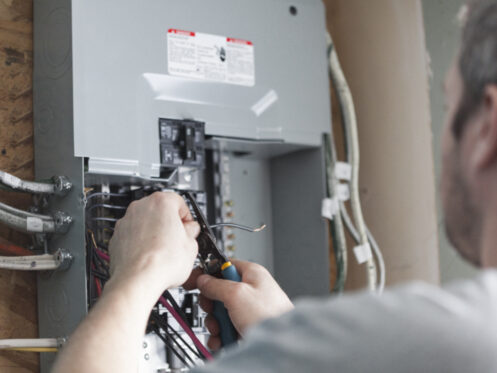Decades ago, futurists speculated that we’d all eventually live in homes that responded spontaneously to our whims. While some of those predictions remain only in science fiction, many are now a reality. Today, it is increasingly possible to add things like automation and voice control to your home. Doing it, however, requires a fair amount of knowledge of what is and isn’t possible. You must also know how to integrate disparate technologies into a single, coherent system. It turns out that the experts here at Top Flight Electric have all of the smart home answers you need. So, here is a guide to home electrical system automation and control for your Winter Haven, FL, home.
Understanding Smart Home Protocols
When you begin researching a smart home system, you will notice that there’s no universal smart home communication standard. That means not every device on the market is compatible with all others. Plus, you’ll find that not every smart home device works with your preferred smart assistant. The following are the major connectivity and control protocols used by today’s smart home gear.
Wi-Fi Networking
Wi-Fi is the basic building block of almost every smart home. It’s the same networking technology devices like smartphones, tablets, and computers use. Smart home devices use Wi-Fi for connectivity with cloud-based control systems and apps. This also allows smart home technology manufacturers to upgrade device firmware and features.
Z-Wave
Z-Wave is another smart home wireless communication protocol that often takes the place of Wi-Fi. It offers short-range mesh networking capabilities and usually works with a network-connected base station. Z-Wave smart home devices talk to one another rather than to a cloud service, offering you more direct control. Also, Z-Wave devices consume far less power than Wi-Fi-enabled ones.
Zigbee
Zigbee is similar to Z-Wave in that it’s a local, short-range smart home networking protocol. It boasts a slightly longer range than Z-Wave and also requires a base station for internet connectivity. Zigbee also supports networks with as many as 65,000 devices connected simultaneously. So, it’s excellent for large homes or businesses with complex smart home integration projects.
Bluetooth Low Energy (BLE)
Much like the Bluetooth protocol supported by your smartphone, Bluetooth Low Energy (BLE) is a short-range communication protocol for smart home devices. It uses significantly less power than ordinary Bluetooth but is designed for short data bursts rather than streaming. It’s ideal for battery-operated smart home devices because it is not always on like regular Bluetooth. Many smart home devices include BLE connectivity to make configuration easier for end users.
Matter
Matter is an open-source smart home communication protocol that aims to increase smart home interoperability. Devices that support Matter will automatically work with all major smart assistants, like Google Home, Amazon Alexa, and Apple’s Siri. After its debut in 2020, an increasing number and variety of smart home devices support Matter each year.
Major Smart Home Device Types
Now that you know the protocols that stitch smart home devices together, you can begin choosing the devices themselves. The following are some of the major smart home devices you can choose from.
Smart Assistants
The core of most smart home systems is a smart assistant. There are three main smart assistants to choose from. They are the aforementioned Google Home, Amazon Alexa, and Apple Siri. However, you can also choose Samsung’s Bixby or Microsoft’s Cortana. All offer voice control functions as well as smart home device grouping. This allows you to pre-define smart home device functions you’d like to co-occur. All of the smart assistants also integrate with stand-alone smart speakers, screens, and even your smartphone.
Smart Lights
One of the most common smart home devices in use today is smart lights. You can turn smart light bulbs and fixtures on and off remotely. Some offer dimmable brightness, and others allow you to control their color. Today’s major smart bulb and fixture manufacturers include Philips, TP-Link, Ring, Govee, and Nanoleaf.
Smart Plugs and Outlets
Smart plugs and outlets are another useful class of smart home devices. These offer remote control of anything plugged into them. Most feature Wi-Fi connectivity and boast interoperability with the major smart assistant platforms. Smart plugs are a good option for remote power control of portable devices. However, smart outlets offer even more control options. There are smart outlets that also include remote-controllable USB ports. That means you can use them to integrate smaller devices into your smart home, too.
Smart Blinds, Curtains, and Shades
There are ways to integrate your home’s window treatments into your smart home, too. These include smart blinds, curtains, and shades. These devices offer motorized operation that gives you full control of them from virtually anywhere. They come in multiple styles and colors, and there are also options for retrofitting your existing curtains.
Smart Thermostats
Smart thermostats offer an inexpensive upgrade for your home’s HVAC system. Most feature learning capabilities that can cut your home’s energy usage significantly. Additionally, many smart thermostats integrate with the major voice assistants. That means you can use them to adjust conditions in your home both remotely and locally via voice controls. There are also a variety of smart thermostat brands to choose from. These include Nest, Ecobee, Honeywell, and Wyze. Some even offer remote temperature and humidity sensors that improve your home’s comfort.
Smart Electrical Panels
Finally, the smart electrical panel is one of the more recent additions to available smart home technology. They offer an intelligent electrical nerve center to help you manage and control your home’s electricity usage. The major smart electrical manufacturers include Span, EcoFlow, Leviton, Savant, and Lumin. Although their features vary, most smart electrical panels provide real-time insight into your home’s electrical use. They let you turn circuits on or off and help integrate things like solar power and battery backups. Smart electrical panels also help you balance electrical loads to prevent exceeding your home’s total electrical service. In many cases, you can install a smart electrical panel to prevent the need for a service upgrade.
Your Local Smart Home Experts
There’s far more to know about smart home technology than can fit in an article. Fortunately, you don’t have to try and become an expert yourself. Instead, you can rely on the smart home experts at Top Flight Electric. We offer complete electrical services to homeowners in Winter Haven and can help with your smart home needs. Plus, we treat every client like a VIP, so we’ll take our time to help you build a smart home you’ll love.
We’re also Better Business Bureau accredited with an A+ rating. That’s one of the ways you can tell that we offer outstanding workmanship and excellent customer care. We even offer financing options on approved credit to help you pay for larger electrical projects. So, if you need help setting up a smart home system or devices in your Winter Haven home, call Top Flight Electric today!

